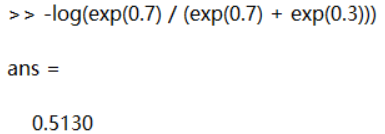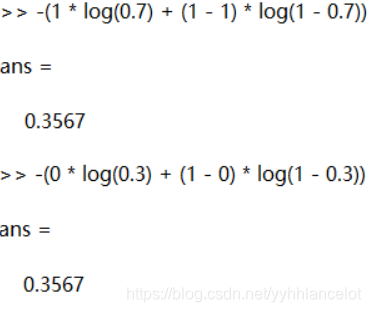最近用pytorch做实验,踩中一些坑,有小有大,这个问题花了我不少时间找到原因,姑且算个大坑。
首先,这几个类分别对应的函数为:
nn.CrossEntropyLoss() ——》nn.functional.cross_entropy()
nn.BCEloss() ——》nn.functional.binary_cross_entropy()
nn.BCEWithLogitsLoss() ——》nn.functional.binary_cross_entropy_with_logits()
类及其对应的函数,它们的label的形式都是一致的;同时类BCEloss()和类BCEWithLogitsLoss()的label形式是完全一致的。所以后面我直接用了函数形式,以此便于读者阅读。
CrossEntropyLoss()是可以进行多分类的交叉熵。BCEloss()是指的二分类的交叉熵。首先在我的个人臆测中,如果做二分类的话,那既可以用CrossEntropyLoss()也可以用BCEloss(),即使输入方式不同,应该达到相同效果才对。
但是实际上,CrossEntropyLoss()内部将input做了softmax后再与label进行交叉熵!BCEloss()内部啥也没干直接将input与label做了交叉熵!BCEWithLogitsLoss()内部将input做了sigmoid后再与label进行交叉熵!
首先看下结果,这里没有用默认的mean,而是使用了none,也是为了读者方便观看。
input_ = torch.tensor([[0.7, 0.3]]) # 二分类,假设得到的结果为对应两个标签的概率分别为0.7,0.3,
#这里并不一定必须要加起来为1,也不一定都需要都在0-1之间,稍后解释
target1 = torch.tensor([0]) # 这里是CrossEntropy形式的label,只需要一个标签表示,假设正确标签是0(一共有0,1两种标签)
target2 = torch.tensor([[1, 0]]).to(torch.float) # 这里是BCEloss形式的label,内部是概率表示
target3 = torch.tensor([[1, 0]]).to(torch.float) # 同上,加这个target是方便读者阅读
#分别对应求loss
loss1 = torch.nn.functional.cross_entropy(input_, target1, reduction = 'none')
loss2 = torch.nn.functional.binary_cross_entropy(input_, target2, reduction = 'none')
loss3 = torch.nn.functional.binary_cross_entropy_with_logits(input_, target3, reduction = 'none')
最后的结果
loss1:
tensor([0.5130])
loss2:
tensor([[0.3567, 0.3567]])
loss3:
tensor([[0.4032, 0.8544]])
接下来验证,我用了matlab来计算
CrossEntropyLoss() / loss1
它加入了一层softmax(所以设置input并不需要加起来为1,也不一定都在0-1之间),且只对target对应的那个数进行计算,所以只有一个值:

BCEloss() / loss2
它直接进行二元交叉熵计算:
是在数据不均衡时使用的,默认为1,这里忽略就好。

BCEWithLogitsLoss() / loss3
它加入了一层sigmoid,再进行二元交叉熵计算:

总结
博主设置input = 0.7,0.3的原因,是默认在计算loss之前经过了softmax,但没想到Pytorch好心办坏事,不过TensorFlow的开发者似乎没有Pytorch的开发者这么细致。之前觉得CrossEntropyLoss()也可以用BCEloss()在二分类应该达到相同效果才对(即softmax和sigmoid在二分类应该达到相同效果),其实是博主记混了,二分类时softmax和sigmoid确实等价
首先假设隐层输出为
。
如果使用sigmoid,输出层有一个节点,值为
。
然后类别1,2的预测概率分别为
如果使用softmax,则输出层有两个节点,值分别为
和
,然后类别1,2的预测概率为
可以看到sigmoid中的
是和softmax中的
是等价的。不管sigmoid网络能产生什么样的预测,也一定存在softmax网络能产生相同的预测,只要令
就可以了。比如将0.7, 0.3输入CrossEntropyLoss(),0.4, xx输入BCEWithLogitsLoss()就会产生相同的损失值了。(xx是为了满足输入形式)。所以在纠结使用哪个loss的时候,还是看个人习惯就好,当然使用CrossEntropyLoss()更方便改用为多分类的模型。



